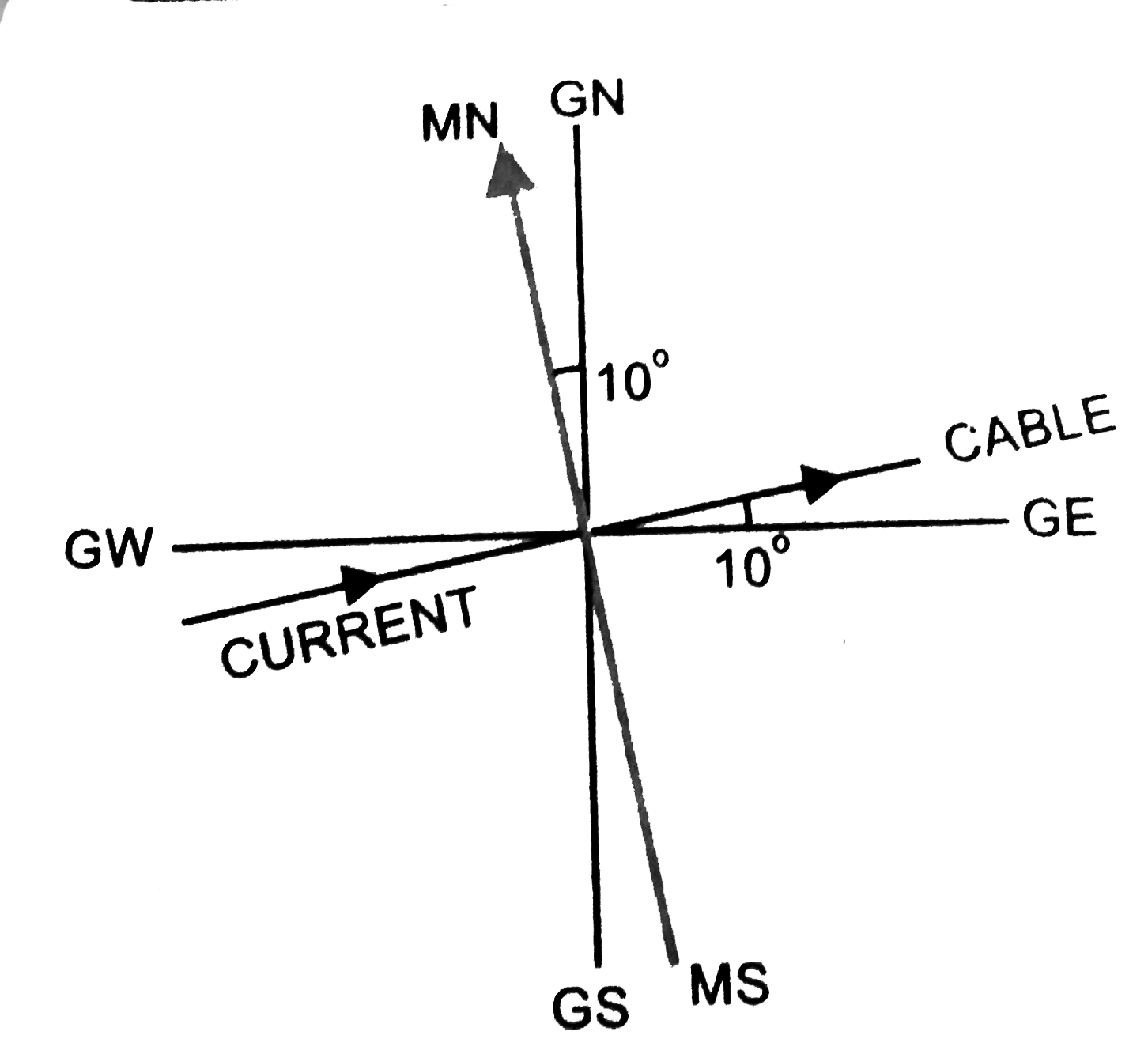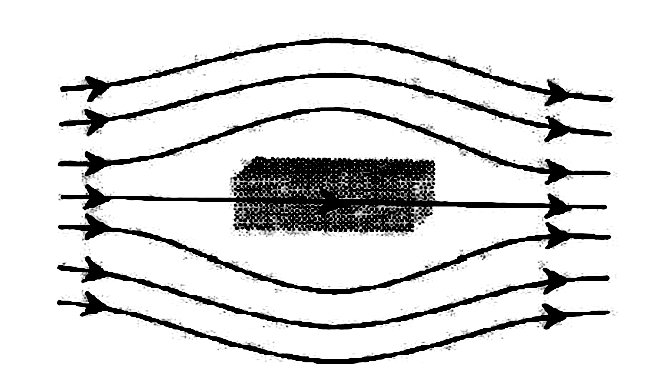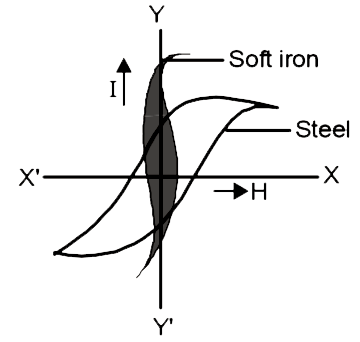Complete Solutions to physics of chapter MAGNETISM AND MATTER of Class 12 book with complete answers and questions
| Class 12 | PHYSICS |
| Chapter | MAGNETISM AND MATTER |
| DISHA | physics |
| Number Of Questions | 58 |
| Academic Year | 2023-24 |
A north pole of strength 50 Am and south pole of strength 100 Am are separated by a distance of 10 cm in air. Find the force between them.
View SolutionCalculate magnetic induction at a distance of 20 cm from a pole of strength 40 Am in air.
View SolutionA bar magnet of length 0.2 m and pole strength 5 Am is kept in a uniform magnetic induction field of strength `15 wb//m^(-2)` making an angle of `30^(@)` with the field. Find the couple acting on it.
View SolutionThe force experienced by a pole of strength 100 Am at a distance of 0.2 m from a short magnet of length 5 cm and pole strength of 200 Am on its axial line will be
View SolutionA magnet of moment M is lying in a magnetic field of induction B. W1 is the work done in turning it from `0^(@)` to `60^(@)` and `W_(2)` is the work done in turning it from `30^(@)` to `90^(@)`. Then
View SolutionA bar magnet of magnetic moment `2.0` `A-m^2` is free to rotate about a vertical axis through its centre. The magnet is released from rest from the east west position. Find the kinetic energy of the magnet as it takes the north south position. The horizontal component of the earth's magnetic field as `B=25muT`. Earth's magnetic field is from south to north.
View SolutionThe length of a bar magnet is 10 cm and its pole strength is `10^(-3)` Weber. It is placed in a magnetic field of induction `4 pi × 10^(-3)` Tesla in a direction making an angle `30^(@)` with the field direction. The value of torque acting on the magnet will be –
View SolutionAt magnetic poles of earth, angle of dip is
View SolutionA short bar magnet is placed with its north pole pointing south. The neutral point is `10cm` away from the centre of the magnet. If `H=0*4` gauss, calculate magnetic moment of the magnet.
View SolutionA bar magnet with its poles 25 cm apart and of pole strength `24.0 A-m` rests with its centre on a frictionless pivot. A force F is applied on the magnet at a distance of 12 cm from the pivot, so that it is held in equilibrium at an angle of `30^(@)` with respect to a magnetic field of induction 0.25 T. The value of force F is
View SolutionA small magnet of magnetic moment 4A-m2 is placed on a deflection magnetometer in tan-B position at a distance of 20cm from the compass needle. At what distance from compass needle should another small magnet of moment `0.5A-m^(2)` be placed such that the deflection of the needle remains zero ?
View SolutionThe ratio of intensities of magnetic field, at distances x and 2x from the centre of magnet of length 2cm on its axis, will be
View SolutionTwo magnets `A` and `B` are identical and these are arranged as shown in the figure. Their length is negligible in comparison to the separation between them. A magnetic needle is placed between the magnets at point P which gets deflected through an angle `theta` under the influence of magnets. The ratio of distance `d_(1)` and `d_(2)` will be

View SolutionThe time period of a freely suspended magnet is 4 seconds. If it is broken in length into two equal parts and one part is suspended in the same way, then its time period will be
View SolutionThe length, breadth and mass of two bar magnets are same but their magnetic moments are 3M and 2M respectively. These are joined pole to pole and are suspended by a string. When oscillated in a magnetic field of strength B, the time period obtained is 5s. If the poles of either of the magnets are reverse then the time period of the combination in the same magnetic field will be –
View SolutionA thin magnetic needle oscillates in a horizontal plane with a period T. It is broken into n equals parts. The time period of each part will be
View SolutionA bar magnet made of steel has a magnetic moment of `2.5 A m^2` and mass of `6.6 xx 10^(-5) kg`. If the density of steel is `7.9 xx 10^3 kg m^(-3)`, find the intensity of magnetization of the magnet.
View SolutionA short magnet of length 4 cm is kept at a distance of 20 cm to the east of a compass box such that is axis is perpendicular to the magnetic meridian. If the deflection produced is `45^(@)`, find the pole strength `(H = 30 Am^(1))`
View SolutionA 10 cm long bar magnet of magnetic moment 1.34 Am2 is placed in the magnetic meridian with its south pole pointing geographical south. The neutral point is obtained at a distance of 15 cm from the centre of the magnet. Calculate the horizontal component of earth’s magnetic field.
View SolutionA 30 cm long bar magnet is placed in the magnetic meridian with its north pole pointing south. The neutral point is obtained at a distance of 40 cm from the centre of the magnet. Pole strength of the magnet is (The horizontal component of earth’s magnetic field is 0.34 Gauss)
View SolutionA long straight horizontal cable carries a current of `2.5amp`. In the direction `10^@` south of west to `10^@` north of east, figure. The magnetic meridian of the place happens to be `10^@` west of the geographic meridian. The earth's magnetic field at the location is `0.33G` and the angle of dip is zero. Locate the line of neutral points (Ignore the thickness of the cable). [At neutral points, magnetic fied due to a current cable is equal and opposite to the horizontal component of earth's magnetic field.]

View SolutionWhich of the following is/are not the main difference between electric lines of force and magnetic lines of force ?
(1) Electric lines of force are closed curves whereas magnetic lines of force are open curves.
(2) Magnetic lines of force cut each other whereas electric lines of force do not cut.
(3) Electric lines of force cut each other whereas magnetic lines of force do not cut.
(4) Electric lines of force are open curves whereas magnetic lines of force are closed curves
View SolutionThe correct statements regarding the lines of force of the magnetic field B are
(1) Magnetic intensity is a measure of lines of force passing through unit area held normal to it
(2) Magnetic lines of force form a closed curve
(3) Due to a magnet magnetic lines of force never cut each other
(4) Inside a magnet, its magnetic lines of force move from north pole of a magnet towards its south pole
View SolutionA short bar magnet of mangetic moment `5*25xx10^-2JT^-1` is placed with its axis perpendicular to earth's field direction. At what distance from the centre of the magnet, is the resultant field inclined at `45^@` with earth's field on (i) its normal bisector, (ii) its aixs? Magnitude of earth's field at the place `0*42G`. Ignore the length of the magnet in comparison to the distances involved.
View SolutionA telephonic cable at a place has four long straight horizontal wires carrying a current of `1.0amp.` in the same direction east to west. The earth's magnetic field at the place is `0.39G` and the angle of dip is `35^@`. The magnetic declination is almost zero. What are the resultant magnetic fields at points `4.0cm` below and above the cable?
View SolutionA telephonic cable at a place has four long straight horizontal wires carrying a current of `1.0amp.` in the same direction east to west. The earth's magnetic field at the place is `0.39G` and the angle of dip is `35^@`. The magnetic declination is almost zero. What are the resultant magnetic fields at points `4.0cm` below and above the cable?
View SolutionStatement-1 : Gauss theorem is not applicable in magnetism. Statement-2 : Mono magnetic pole does not exist.
View SolutionAssertion: A compass needle when placed on the magnetic north pole of the earth rotates in vertical direction.
Reason: The earth has only horizontal component of its magnetic field at the north poles.
View SolutionAssertion: We cannot think of magnetic field configuration with three poles.
Reason: A bar magnet does exert a torque on itself due to its own field.
View SolutionSusceptibility of ferromagnetic substance is
View SolutionAmong the following properties describing diamagnetism identify the property that is wrongly stated
View SolutionIf the magnetic dipole of moment of an atom of diamagnetic material, paramagnetic material and ferromagnetic material are donated by `mu_d, mu_p` and `mu_f` respectively, then:
View SolutionWhen a piece of a ferromagnetic sobstance is put in a uniform magnetic field, the flux density inside it is four times the flux density away from the piece. The magnetic permeability of the material is
View SolutionThe given figure represents a material which is

View SolutionLiquid oxygen remains suspended between two pole faces of a magnet because it is
View SolutionA superconductor exhibits perfect
View SolutionWhich of the following is most suitable for the core of electromagnets?
View SolutionThe universal proporty among all substance is
View SolutionIf a magnetic substance is kept in a magnetic field, then which of the following is thrown out?
View SolutionIn the hysteresis cycle, the value of H needed to make the intensity of magnetisation zero is called
View SolutionIf a diamagnetic solution is poured into a U-tube and one aem of this U-tube placed between the poles of a strong magnet with the meniscus in a line with the field, then the level of the solution will
View SolutionThe relative permeability is represented by `mu_(r)` and the susceptibility is denoted by `chi` for a magnetic substace. Then for for a paramagnetic subatance
View SolutionThe use of study of hysteresis curve for a given material is to estimate the
View SolutionThe magnetic moment of atomic neon is
View SolutionA ferromagnetic material is heated above its curie temperature. Which one is a correct statement?
View SolutionIf a diamagnetic substance is brought near north or south pole of a bar magnet, it is
View SolutionThe material of permanent magnet has
View SolutionDiamagnetic substances are
View SolutionFor an isotropic medium `B, mu, H` and `M` are related as (where `B`, `mu_(0)`, H and M have their usual meaning in the context of magnetic material
View SolutionRelative permeability of iron is 5500, then its magnetic susceptibility will be
View SolutionA magnetising field of `2 xx 10^(3) amp//m` produces a magnetic flux density of `8pi` Tesla in an iron rod. The relative permeability of the rod will be
View SolutionThe mass of a specimen of a ferromagnetic material is 0.6 kg. and its density is `7.8 xx 10^(3) kg//m3`. If the area of hysteresis loop of alternating magnetising field of frequency 50Hz is 0.722 MKS units then the hysteresis loss per second will be

View SolutionA diamagnetic material in a magnetic field moves
View SolutionA magnetic field of `1600Am^-1` produces a magnetic flux of `2*4xx10^-5` weber in a bar of iron of cross section `0*2cm^2`. Calculate permeability and susceptibility of the bar.
View SolutionWhich of the following statments are false about the magnetic susceptibility m c of paramagnetic substance?
Value of `chi_(m)` is directly proportional to the absolute temperature of the sample
`chi_(m)` is negative at all temperature
`chi_(m)` does not depend on the temperature of the sample
`chi_(m)` is positive at all temperature
View SolutionAssertion: The ferromagnetic substance do not obey Curie's law.
Reason: At Curie point a ferromagnetic substance start behaving as a paramagnetic subsrance.
View SolutionAssertion: A paramagnetic sample display greater magnetisation (for the same magnetising field) when cooled.
Reason: The magnetisation does not depend on temperature.
View SolutionAssertion: The permeability of a ferromagnetic material is independent of the magnetic field.
Reason: Permeability of a material is a constant quantity.
View Solution
physics questions and complete solutions for chapter MAGNETISM AND MATTER of DISHA PHYSICS (HINGLISH) of Class 12